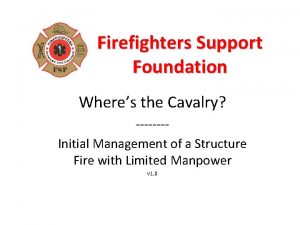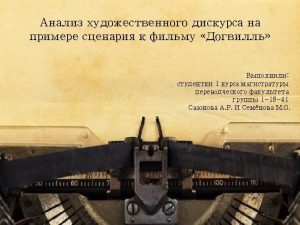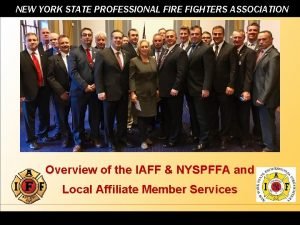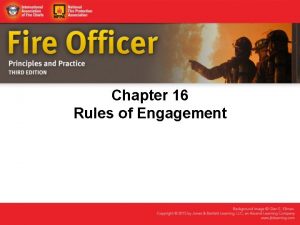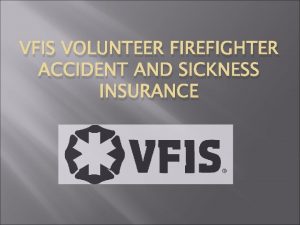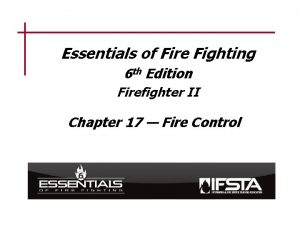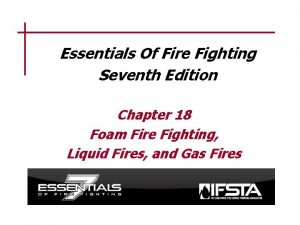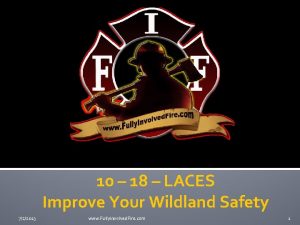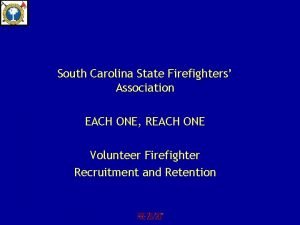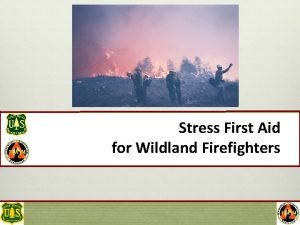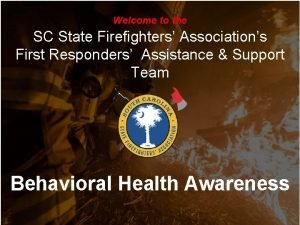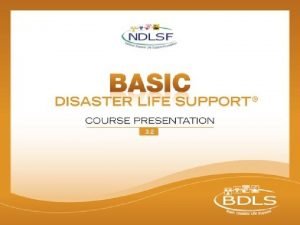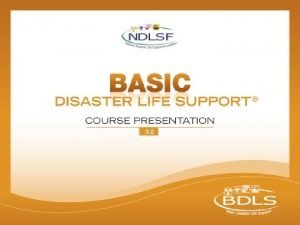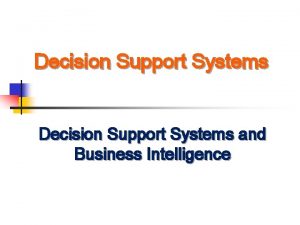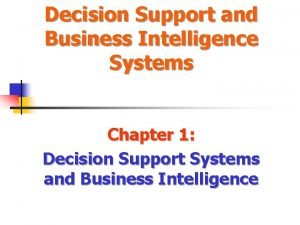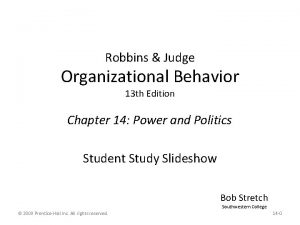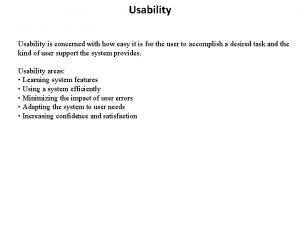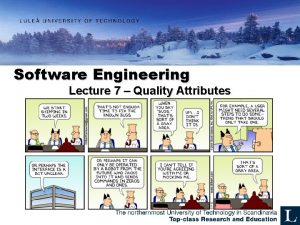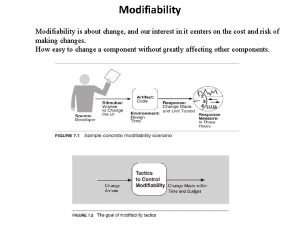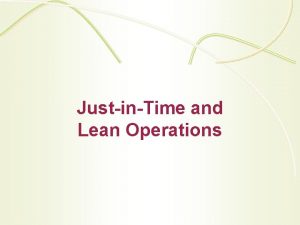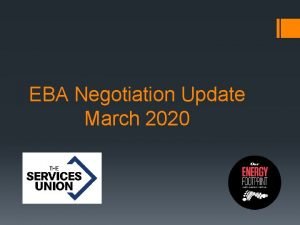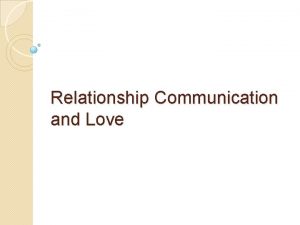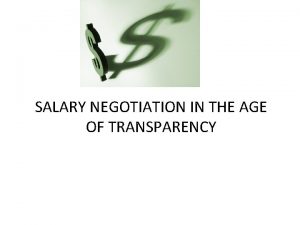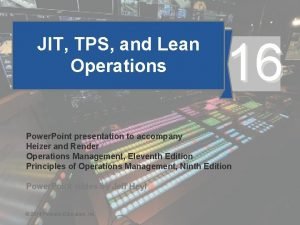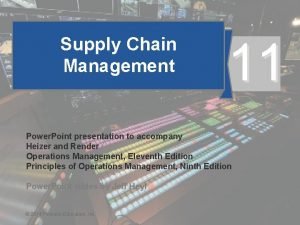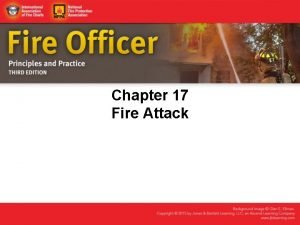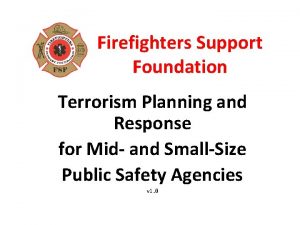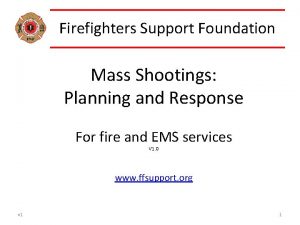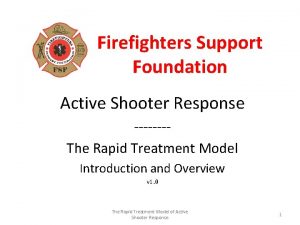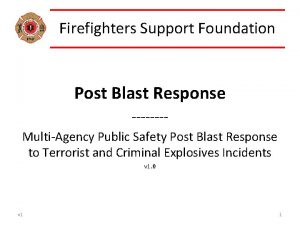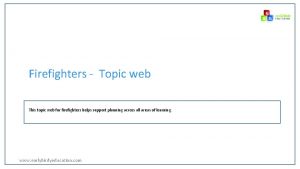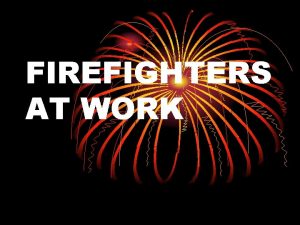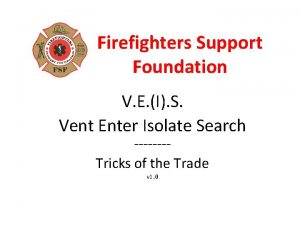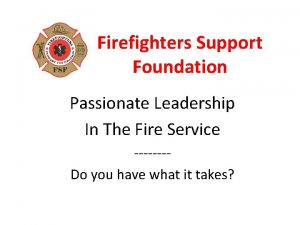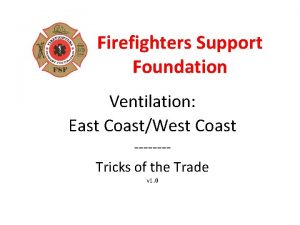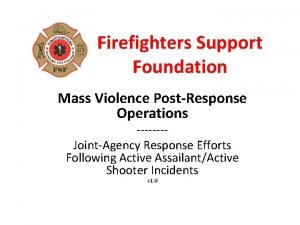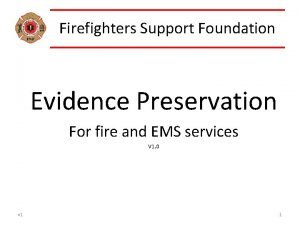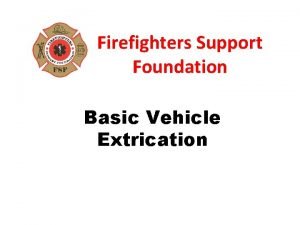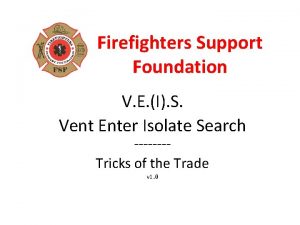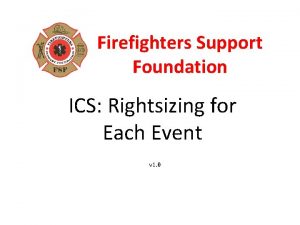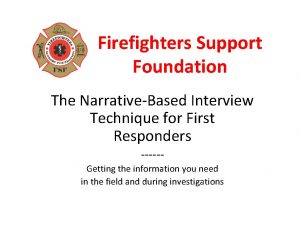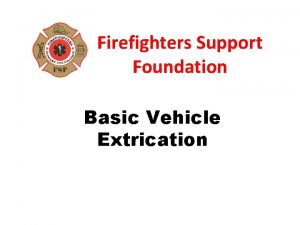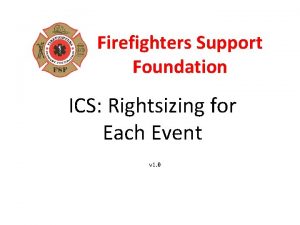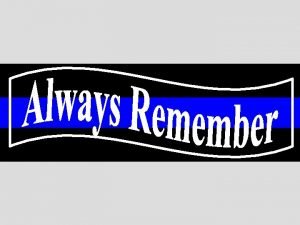Firefighters Support Foundation Response to Gunfire Tactics when
















































- Slides: 48

Firefighters Support Foundation Response to Gunfire -------Tactics when shot at or working at ballistic events v 1. 0

About FSF The Firefighters Support Foundation is a 501 c 3 non-profit organization whose primary mission is to develop, produce and distribute training programs to firefighters and all first responders. All of our programs are distributed free of charge. Response to Gunfire 2

Permission is granted to reproduce or distribute this material so long as the Firefighters Support Foundation is credited as the source Response to Gunfire 3

Accompanying Video This Power. Point presentation accompanies the video presentation of the same title. Response to Gunfire 4

Presenter Lt. Rick Hetzel is the commander of the state police SWAT team in a large, active southeastern state. He has extensive experience training and working with firefighters and EMS personnel at ballistic events. Response to Gunfire 5

Purpose & Audience • To familiarize firefighters with fundamental actions during the initial stages of a critical incident until law enforcement officers / a Special Response Team (SWAT) arrives onscene • To familiarize police personnel with the issues of working with fire and EMS at critical scenes Response to Gunfire 6

The Need for Cooperation • As a first responder who has either arrived on -scene or became involved in a critical situation in-progress, there are certain tactics, techniques, and procedures that should be considered prior to the arrival of the LEO’S and/or a Special Response Team. • Your actions may prove critical to a peaceful resolution Response to Gunfire 7

First Responder Obligations It’s easy to become overwhelmed by events, but you must prioritize what needs to be accomplished first based on the circumstances • Active shooter: requires immediate response • Officer/citizen down: requires a rescue plan • Hostage Situation: immediate containment is the initial responding LE Goal. Firefighters should formulate a hasty escape plan in case suspect initiates a deadly assault on first responders Response to Gunfire 8

First Responder Obligations (2) • As additional resources arrive, set a larger perimeter • Assign a supervisor to oversee the overall effort, who will become LE / SRT point of contact. Ensure they have a solid understanding of what the situation is and what goals you are trying to achieve • Be mindful that these situations can last many hours. Remember to care for the needs of the personnel involved Response to Gunfire 9

Types of SRT Responses Where Firefighters Might Be Involved • Barricaded Suspects • Hostage Situations • High Risk Search Warrants • Executive/Witness Protection • Events that require an immediate resource of tactical personnel Response to Gunfire 10

You Might Wind Up Here Response to Gunfire 11

Seek Cover and Concealment • Cover – Protection from gunfire; brick/stone walls, large tree trunks, and vehicle engine blocks • Concealment – Anything that hides you from observation by a hostile threat; does not necessarily protect you from gunfire • Just because the shooter can’t see you does not mean he can’t hurt you! Response to Gunfire 12

Cover and Concealment (2) • When it comes to cover remember that “not all rounds are created equal” • What may serve as cover from a. 22, 9 mm, or 38, will not serve as cover against a 223, 308, or a 50 Cal. (people do own them!) • Pick your cover as if your life depends on it ! Response to Gunfire 13

Evacuate Potential Hostages/Neighbors • Any person you can safely get out of the area, do so immediately • The ultimate goal is to isolate threat • Create a safety zone for SRT • If the situation is too dangerous, advise persons to stay inside their residence/workplace, until the incident is resolved or additional LE personnel arrive on-scene Response to Gunfire 14

Perimeter A layering of security around an anticipated or surprise target location to ensure the containment of individuals within that location and the exclusion of other individuals from that location who might present a threat to law enforcement and emergency personnel directly involved in the evolving situation. Response to Gunfire 15

Exclusion Upon establishing an outer perimeter, no individual , be it a suspect, civilian neighbor, or the media, will be allowed into the inner perimeter. The outer perimeter will be looking outward for threats or distractions approaching the area of operations as well as inward. Response to Gunfire 16

Pick a Suitable Staging Area • The Staging Area is a location where the SRT can safely assemble, kit-up, and develop a course of action • Often located in proximity of the CP • Location should not be too far from the incident, but not within observation of the suspect(s) line of fire • Location of the Staging Area must be able to accommodate SRT’s vehicles, personnel, and associated resources (EOD/Bomb Unit, EMS, Fire) Response to Gunfire 17

Make Room for this Stuff Response to Gunfire 18

Keep Lanes of Traffic Open • The first responders on-scene should communicate the safe areas to park responding vehicles • Keep a clear lane from the Staging Area to the Crisis Site – keep vehicles out of the way • Remember, there will be numerous types of vehicles responding to the scene (Fire, EMS, EOD, SRT, Utility, etc…) • It may be necessary to remove and transport injured officers or citizens Response to Gunfire 19

Armed Encounters What to expect within ourselves to occur in an armed / combat style encounter The study of mans behavior in combat is a study of paradoxes, enigmas and extremes. The combat experience is an intangible, and hides deep in the recesses of the human psyche. Therefore, the combat experience is difficult to chart with scientific measurements and even more difficult for the world of scholars and historians to enter. Bruce Siddle, excerpted from Lt Col Dave Grossmans “On Combat” Response to Gunfire 20

Parasympathetic Nervous System • Takes over when the body is relaxed or when you are sleeping. • Body performs normal bodily functions at normal levels. • Includes things such as digesting food, maintaining blood pressure and resting heart rate levels of about 60 -80 bpm depending on the individual. • The PNS controls low arousal states. Response to Gunfire 21

Sympathetic Nervous System • Activates under conditions that invoke a stress induced response (you perceive a threat). • The body experiences a high arousal state. • Once the high arousal state reaches a certain level, it may take on negative overtones, which most would identify as fear. Response to Gunfire 22

Fear • Fear is Mother Natures way of telling you that your life is in immediate danger and that you better do something to save it. • Fear brings about a chemically altered state that gives you an extra survival edge. • These natural changes compel you to instinctively, and without hesitation, to do one of three things to preserve your own life: – Fight – Flight – Freeze Response to Gunfire 23

Physical Changes from Fear • • Increased heart rate • Tensing of muscles • Trembling • Rapid, shallow breathing • Dizziness • Nausea Gut-wrenching knot • Sweating • Response to Gunfire Dry mouth Goose bumps Tingling sensation in limbs and or face Insensitive to pain Jumpy, easily startled Urge to urinate Urge to defecate 24

Thought “No man fears to do that which he knows he does well. ” Duke of Wellington Response to Gunfire 25

Perceptual Distortions in Combat From Deadly Force Encounters by Dr. Alexis Artwohl & Loren Christensen Based on survey of 141 Officers • • • • 85% Diminished Sound (auditory exclusion) 16% Intensified Sounds 80% Tunnel Vision 74% Automatic Pilot (“Scared Speechless”) 72% Heightened Visual Clarity 65% Slow Motion Time 7% Temporary Paralysis 51% Memory Loss for Parts of the Event 47% Memory Loss for Some of Your Actions (“Perseveration”) 40% Dissociation (detachment) 26% Intrusive Distracting Thoughts 22% Memory Distortions (“Perceptual Set? ”) • (Role of fear and past associations) • (Role of videotaping) For additional info on perceptual distortions in combat, Into 16% Fast Motion Time the Kill Zone by Dr. David A. Klinger is highly recommended. www. killology. com Response to Gunfire 26

Auditory Exclusion / Tunnel Vision “Everything I’ve seen tells me that most auditory exclusion (like most tunnel vision) is a matter of cortical perception. The ears still hear and the eyes still see, but as it focuses on the survival mission, the cortex of the brain is screening out awareness of what it deems insignificant to the goal. ” Massad Ayoob, national champion competitive shooter, law enforcement trainer, leading researcher, and one of the most prolific police writers today, in a personal correspondence to Dave Grossman Response to Gunfire 27

EFFECTS OF HORMONAL OR FEAR INDUCED HEART RATE INCREASE Beats Per Minute 220 Above 175 bpm: -Irrational fight or flee -Freezing -Submissive behavior -Voiding of bladder and bowels -Gross motor skills (running, charging, etc. at highest performance level) 200 180 160 115 -145 bpm = optimal survival and combat performance level for: -Complex motor skills -Visual reaction time -Cognitive reaction time 140 120 Notes: 175 bpm : -Cognitive processing deteriorates -Vasoconstriction (=reduced bleeding from wounds) -Loss of peripheral vision (tunnel vision) -Loss of depth perception -Loss of near vision -Auditory exclusion Condition Black 2. Condition Gray 145 bpm: Complex motor skills deteriorate Condition Red 115 bpm: Fine motor skill deteriorates 100 80 1. Condition Yellow 60 -80 bpm: normal Resting heart rate © Copyright 1997 Siddle & Grossman Condition White (Psychological Condition) Response to Gunfire 3. This data is for hormonal or fear induced heart rate increases resulting from sympathetic nervous system arousal. Exercise induced increases will not have the same effect. Hormonal induced performance and strength increases can achieve 100% of potential max within 10 seconds, but drop 55% after 30 seconds, 35% after 60 seconds, and 31% after 90 seconds. It takes a minimum of 3 minutes of rest to “recharge” the system. Any extended period of relaxation after intense sympathetic nervous system arousal can result in a parasympathetic backlash, with significant drops in energy level, heart rate and blood pressure. This can manifest itself as normal shock symptoms (dizziness, nausea and/or vomiting, clammy skin) and/or profound exhaustion. 28

Stress Inoculation “There is evidence to indicate that world class experts in top physical condition, under specific, controlled situations, can use autopilot and stress inoculation (acclimatization) to push the envelope of Condition Red into the Grey Zone. ” Excerpt from Lt Col Dave Grossmans “On Combat” Response to Gunfire 29

Stress Inoculation Training • You can learn to survive a stressful situation by inoculating yourself against it. Stress Inoculation Training (SIT) is a concept that was developed by psychologist Donald Meichenbaum, Ph. D. • Using well known principles, SIT teaches cognitive, behavioral, and emotional skills needed to cope effectively with a stressor such as deadly force. • SIT consists of three phases: – Conceptualization of the stressor – Skills acquisition and rehearsal – Application and follow-through Response to Gunfire 30

What Does it Take to Survive? Ø Mental Preparation Ø Physical Ability Ø Practical Skills Response to Gunfire 31

INDIVIDUAL FIREFIGHTER / EMS AND TEAM MOVEMENT TECHNIQUES Response to Gunfire 32

Purpose • To train Firefighters and EMS first responder personnel to move tactically as an individual, and collectively as a team, during high-risk calls, including an active shooter situation, barricaded shooter and hostage situations. • Or sadly, to the scene of a regular incident that was staged as a part of an ambush aimed specifically at them ! Response to Gunfire 33

Purpose (cont. ) • As a member of a fire department or EMS unit, it is essential that you understand how to move as an individual and as a member of a team. • Moving into an area that poses the threat of possible armed confrontation requires that all personnel understand how to tactically move and quickly react to a hostile threat. • Individual movement techniques, or “IMT” enhance the prospects of survival and a successful mission. Response to Gunfire 34

IMTs - Introduction • Individual movement techniques are basic tactics and are employed at the individual and team level. • IMTs are based on the principle of fire-and-maneuver. That is, firing and moving, often in pairs, with one member firing to suppress the threat while the other moves either toward the threat or to a more protected position. • You will not be firing at anyone but these techniques can work for you to maneuver yourself into a more safe and secure defensive position. Response to Gunfire 35

Basic IMTs • Rush • High Crawl • Low Crawl Response to Gunfire 36

The Rush • Fastest way to move from one position to another • Movements of 3 to 5 seconds in duration • Always try to hit the ground behind some cover. • Before moving, pick out your next covered and concealed position Response to Gunfire 37

The High Crawl • Allows you to move faster than the low crawl • Gives you a low silhouette • Use when there is good concealment but hostile fire prevents you from getting up Response to Gunfire 38

The Low Crawl • Gives you the lowest silhouette • Use where the concealment is very low and hostile fire or observation prevents you from getting up • Keep your body flat against the ground Response to Gunfire 39

Other IMTs Do not carry unnecessary equipment. Try to move from covered position to another Stop, look, and listen before moving Identify your next position before leaving a position • Use environmental noises, such as generators, vehicles, trains, aircraft, and wind to conceal movement noises • • Response to Gunfire 40

Movement Formations • WEDGE • FILE • DIAMOND Response to Gunfire 41

The Wedge Team Leader Response to Gunfire 42

The Wedge (2) Response to Gunfire 43

The Wedge (3) Response to Gunfire 44

The Team File Team Leader Response to Gunfire 45

The Diamond Response to Gunfire 46

The Diamond (2) Response to Gunfire 47

React to Hostile Fire • A quick decision is necessary in order to reduce team exposure to potentially lethal fire from a hostile threat • If you are taking accurate and direct fire, you must immediately locate the source of the fire and move to protect yourself and other team members • Once the location of the hostile threat is identified, the location must be announced so that every team member is aware • The team/squad leader will make the decision whether to stay in location at cover (such as a fire truck) or to move. The team/squad leaders decision will be determined by the severity of the situation Response to Gunfire 48
 Firefighters support foundation
Firefighters support foundation Gunfire chapter 1
Gunfire chapter 1 New york state professional firefighters association
New york state professional firefighters association Rules of engagement for firefighters
Rules of engagement for firefighters Vfis firefighters insurance
Vfis firefighters insurance At a bulk transport incident, firefighters must:
At a bulk transport incident, firefighters must: At a bulk transport incident firefighters must
At a bulk transport incident firefighters must Laces wildland
Laces wildland Sc firefighters association
Sc firefighters association Stress first aid for firefighters
Stress first aid for firefighters South carolina state firefighters association
South carolina state firefighters association Shallow pad foundation
Shallow pad foundation Composition of urine
Composition of urine Firefighter mayday acronyms
Firefighter mayday acronyms National disaster life support foundation
National disaster life support foundation European foundation for support of culture
European foundation for support of culture National disaster life support foundation
National disaster life support foundation Cushing's support & research foundation
Cushing's support & research foundation Natural response and forced response
Natural response and forced response First order system transfer function
First order system transfer function Primary immune response and secondary immune response
Primary immune response and secondary immune response Dss in business intelligence
Dss in business intelligence Business pressure response support model
Business pressure response support model Grammatical signals examples
Grammatical signals examples Preferred power tactics by influence direction
Preferred power tactics by influence direction Mission vision
Mission vision Broker pattern
Broker pattern Usability tactics
Usability tactics Monitorability tactics
Monitorability tactics Modificability
Modificability Bogey tactic
Bogey tactic What is jit
What is jit Tactics and strategy
Tactics and strategy Tactics for matching capacity to demand
Tactics for matching capacity to demand Distribution tactics
Distribution tactics Jingles are musical messages written around the brand.
Jingles are musical messages written around the brand. Alexander the great's timeline
Alexander the great's timeline Eba negotiation tactics
Eba negotiation tactics Companionate love
Companionate love Interoperability quality attribute
Interoperability quality attribute Police defensive tactics
Police defensive tactics Managerial economics applications strategy and tactics
Managerial economics applications strategy and tactics Types of public relations
Types of public relations Microsoft negotiation strategy
Microsoft negotiation strategy Ashley drew scare tactics
Ashley drew scare tactics Jit tps and lean operations
Jit tps and lean operations Supply chain table
Supply chain table Supplements for field hockey
Supplements for field hockey Receo vs fire
Receo vs fire
